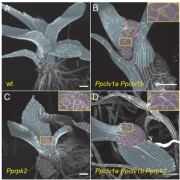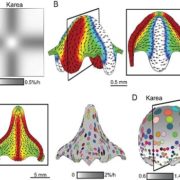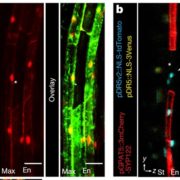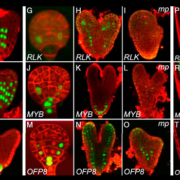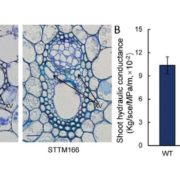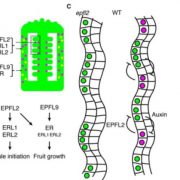Review: Stem cells of the vascular cambium
 Vascular cambium cells are meristematic cells responsible for secondary growth. Lineage tracing studies in Arabidopsis and poplar show the presence of single bifacial stem cells in each radial cell file that produce xylem inwards and phloem cells outwards. In a recent review, Wybouw et al. discuss the concept of stem cells in vascular cambium. The review begins with a discussion of how secondary growth is mediated by phytohormones and peptide signaling. Next, they discuss three stem cell identities found within the vascular cambium: stem cells, organizer cells, and transit-amplifying cells. The stem cells are capable of continuously resupplying themselves through division. The organizer cells nonautonomously promote stem cell identity in the adjacent cells, Transit-amplifying cells are dividing cells of which daughter cells lose dividing capacity over time, although studying transit-amplifying cells is difficult due to low occurrence in Arabidopsis. Studying stem cells is also difficult due to challenges in positioning them in vascular cambium. While lineage studies can retrospectively inform the position of stem cells, more precise methods such as live imaging of cell division using confocal microscopy is not yet possible as cambium tissues are deep inside the plant. The authors hope that future studies can elaborate the exact roles of factors discussed and the possibility of translating these findings into other species besides Arabidopsis and poplar. (Summary by Kumanan N Govaichelvan, @NGKumanan) New Phtyol. 10.1111/nph.19897
Vascular cambium cells are meristematic cells responsible for secondary growth. Lineage tracing studies in Arabidopsis and poplar show the presence of single bifacial stem cells in each radial cell file that produce xylem inwards and phloem cells outwards. In a recent review, Wybouw et al. discuss the concept of stem cells in vascular cambium. The review begins with a discussion of how secondary growth is mediated by phytohormones and peptide signaling. Next, they discuss three stem cell identities found within the vascular cambium: stem cells, organizer cells, and transit-amplifying cells. The stem cells are capable of continuously resupplying themselves through division. The organizer cells nonautonomously promote stem cell identity in the adjacent cells, Transit-amplifying cells are dividing cells of which daughter cells lose dividing capacity over time, although studying transit-amplifying cells is difficult due to low occurrence in Arabidopsis. Studying stem cells is also difficult due to challenges in positioning them in vascular cambium. While lineage studies can retrospectively inform the position of stem cells, more precise methods such as live imaging of cell division using confocal microscopy is not yet possible as cambium tissues are deep inside the plant. The authors hope that future studies can elaborate the exact roles of factors discussed and the possibility of translating these findings into other species besides Arabidopsis and poplar. (Summary by Kumanan N Govaichelvan, @NGKumanan) New Phtyol. 10.1111/nph.19897


